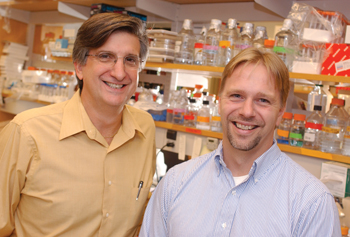
Pat Levitt, Ph.D., left, and Daniel Campbell, Ph.D., have identified a common gene variant that more than doubles the risk of autism.
Photo by Mary Donaldson
Gene variant carries increased risk of autism
Researchers have identified a common gene variant that more than doubles the risk of autism.
The research, led by investigators at the Vanderbilt Kennedy Center for Research on Human Development, provides new insights into the genetic basis of the complex disorder.
In this week's online edition of the Proceedings of the National Academy of Sciences, an international team of scientists led by research fellow Daniel Campbell, Ph.D., and Pat Levitt, Ph.D., report that a genetic variant associated with the MET gene is common in children with autism and appears more frequently in families that have more than one affected child.
Although both environmental and genetic factors are likely involved in autism, mounting evidence suggests that genes play an important role in an individual's susceptibility to the disorder.
“Autism is recognized as the most highly heritable neuropsychiatric disorder,” said Levitt, professor of Pharmacology and director of the Vanderbilt Kennedy Center. “In identical twins, the concordance is between 70 percent and 90 percent, meaning that if one twin has autism, the other twin is at very high risk of having the disorder.”
While the search for autism vulnerability genes has intensified in recent years, most studies have identified only linkage peaks, or areas on specific chromosomes where such genes might lie.
Chromosome 7 contains several such “hotspots,” but few promising susceptibility genes have been identified in the region.
While conducting research on genes involved in brain development in mice, Levitt's team had found that the MET gene — a gene typically associated with cancer — was involved in the development of certain circuits within the cerebral cortex, a brain region whose development is disrupted in autism.
“This gene also happens to be located in one of those 'hotspots,'” Levitt said.
Additionally, MET has known roles in the development of the cerebellum — another brain region implicated in autism — and in immune system regulation and gastrointestinal repair. Some children with autism exhibit medical problems related to those systems.
Given these associations and MET's chromosomal location, Levitt wondered if this gene could be involved in autism vulnerability.
In the current study, Levitt and colleagues analyzed the MET gene in more than 700 families who had at least one child with autism. They found that children with autism commonly had a specific change in the sequence of the promoter region of the gene, the part of the gene that regulates the amount of MET protein produced.
“This variant is in the part of the gene that controls how much of the gene gets expressed…kind of like 'volume control' on a stereo,” Levitt said.
People with two copies of this variant were 2.27 times as likely to have autism as the general population. Individuals with only one copy were also at higher risk (1.67 times) than those without the variant.
“This is a relatively common variant, seen in about 47 percent of the population,” Levitt said. “So why doesn't everybody have autism?”
That speaks to the environmental and other genetic contributions, Levitt said.
“Genes create a vulnerability that then gets coupled with some environmental disturbance — but right now, we don't have any idea what those factors might be.”
But these findings do help set the stage for more in-depth investigation of the interaction between genes and environmental factors in animal models.
Levitt is now creating animals with this genetic variant to assess environmental contributions and probe the underlying biology of autism.
“This mutation itself is not going to be diagnostic,” he said.
But if other genetic variations are identified that carry similar robust associations with autism, screening for a combination of these variants could facilitate the early identification of those at high risk of autism.
And improving early diagnosis might be the best way to help treat or prevent the disorder.
“The more genetic vulnerability genes we identify, the better handle we have on designing experiments to look at gene-environment interactions,” Levitt said.
“We think this will be the way to understand autism and prevent it.”
Campbell, a research fellow in Levitt's lab, was first author on the paper. Other Vanderbilt authors were: James Sutcliffe, Ph.D., and Philip Ebert, Ph.D.
The research was funded by grants from the National Institutes of Health, the Marino Autism Research Institute, Telethon-Italy, Cure Autism Now, the National Alliance for Autism Research, the Fondation Jerome Lejeune, and the National Alliance for Research on Schizophrenia and Depression.













